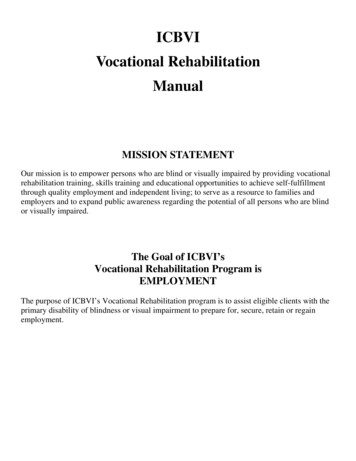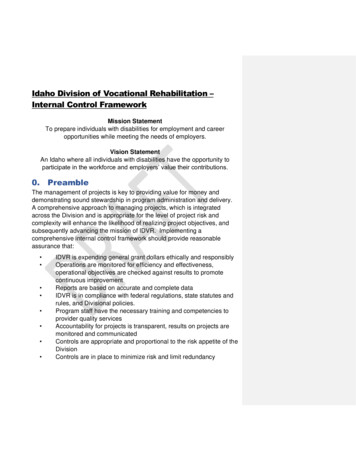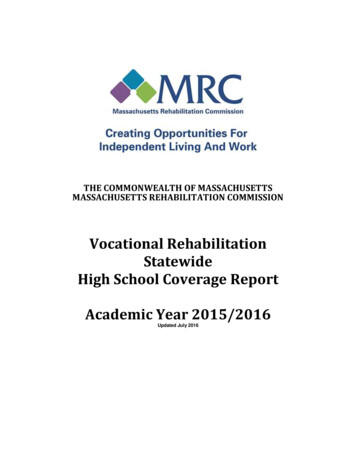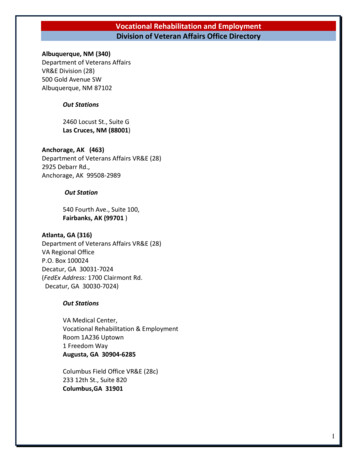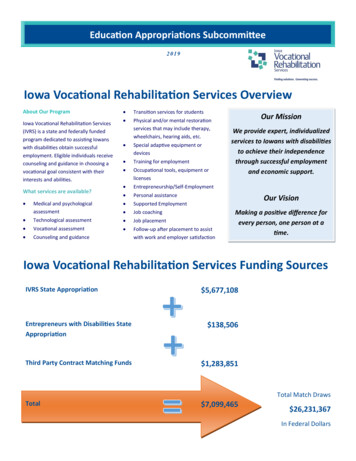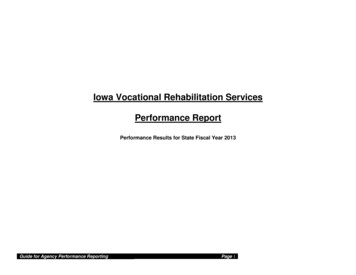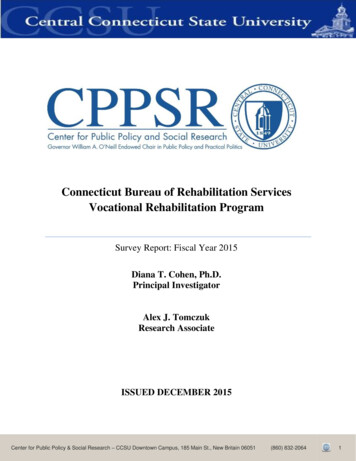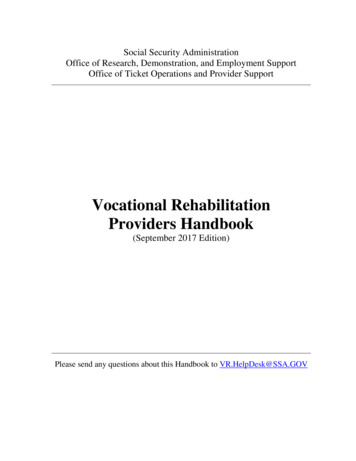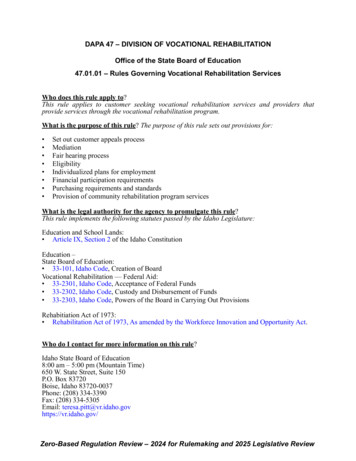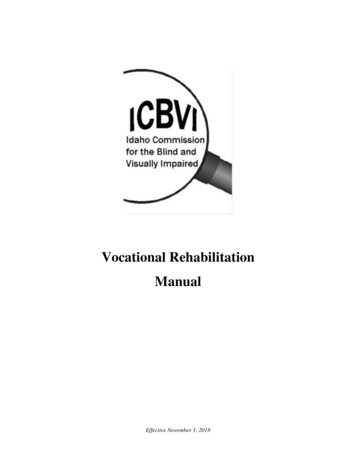
Transcription
Vocational RehabilitationManualEffective November 1, 2018
This page is left intentionally blank1
Table of ContentsIntroduction .6ICBVI Mission Statement.6Purpose of the Vocational Rehabilitation Program .7Legal Citations. 7Protection, Use and Release of Personal Information .8Ethics .9Appeals Process . 10Appeals Process Flow Chart . 11Client Assistance Program. 12Information, Referral and Application for VR Services . 13Residency Requirements . 14Documentation required for eligibility . 16Trial Work Experience (TWE) . 17Eligibility Determination . 19Definitions . 19Eligibility Process . 20Determination of Significance of Disability . 21Individualized Plan for Employment . 23Informed Client Choice . 23Comprehensive Assessment. 23Content of the Individualized Plan for Employment . 25Mandatory Components. 25Supported employment requirements . 26Post-employment services . 26Coordination of services for students with disabilities . 27Required Information . 272
Options for developing an individualized plan for employment . 27Additional Information . 27Mandatory Procedures . 28Implementation of the IPE . 28Amending the IPE . 29Annual Review of the IPE . 29Vocational Rehabilitation Services . 30Pre-Employment Transition Services . 30Training Services . 30Career Services . 32Other Services . 35Fiscal Policy and Fee Schedule . 38Purchasing of Goods and Services . 38Purchase of Gift Cards for VR services . 39Financial Needs Assessment (FNA) . 39Comparable Benefits. 41Fee Schedule . 42Exception Policy . 49Competitive Integrated Employment . 50Definition . 50Required Documentation . 51Customized Employment . 52Overview. 52Temporary Employment . 54Self-Employment . 55Introduction. 55Eligibility Requirements . 55Required Activities . 56Supported Employment Services . 593
Supported Employment . 59Supported Employment Strategy . 59Ongoing Support Services . 60Extended Services . 60Extended Services for Youth . 61Natural Supports . 61Employment Stabilization . 62Allowance for less than competitive wage on a short-term basis . 62Successful Closure Requirements . 63Statewide Supported Employment Program . 64Services for Individuals Employed or Seeking Employment at Subminimum Wage . 65Purpose of Section 511 . 65General Requirements for CC/I&R. 65Additional Requirements for Youth . 66Documentation . 66Transition Services . 67Preamble . 67Definitions . 67Pre-Employment Transition Services (Pre-ETS) . 68Required Activities . 68Coordination Activities . 74Authorized Activities . 74Time Tracking . 75Transition Services under an Order of Selection . 75Required Data Elements . 76Program Exit . 77Competitive Integrated Employment . 77Supported Employment . 77Program Exit Without an Employment Outcome . 794
Post-Employment Services . 80Post-Employment Services (PES) Closure . 80Order of Selection . 81Post-Employment Services (PES) under an OOS . 83Special Exemption to OOS . 83Supporting Documentation for Case Service Report (RSA-911) . 84Date of Application . 84Date of Eligibility Determination . 84Date of IPE . 85Start Date of Employment in Primary Occupation . 85Employment Status at Closure . 85Weekly Earnings at Employment . 86Type of Closure . 86Date of Closure . 87Revision History . 885
IntroductionThis manual is intended for use by the Idaho Commission for the Blind and Visually ImpairedVocational Rehabilitation staff.This manual is also available for reference on the ICVBI public website for the citizens of Idaho.ICBVI Mission StatementThe mission of ICBVI is to empower persons who are blind or visually impaired by providingvocational rehabilitation training, skills training and educational opportunities to achieve selffulfillment through quality employment and independent living.Our mission is fulfilled through the provision of the following programs and services:1) A continuum of services from youth transition to older blind services.2) Skills training that enables people to remain independent in their homes and beengaged in their communities.3) Employment counseling, training, and job placement.4) Individual and group counseling addressing adjustment issues to vision loss andblindness.5) Resources for employers who hire or retain employees who are blind or visuallyimpaired.6) Training in adaptive skills for reading, computer use, traveling, job seeking and otherskills that promote independence and increase work readiness.7) Supported employment programs for individuals with the most significant disabilities.8) Education intended to expand the public’s awareness regarding the abilities andpotential of people who are blind or visually impaired.6
Purpose of the Vocational Rehabilitation ProgramEmployment outcome means, with respect to an individual, entering, advancing in, or retainingfull-time or, if appropriate, part-time competitive integrated employment, (including customizedemployment, self-employment, telecommuting, or business ownership), or supportedemployment that is consistent with an individual's unique strengths, resources, priorities,concerns, abilities, capabilities, interests, and informed choice (34 CFR 361.5).Competitive employment is work performed in the integrated labor market in which the client iscompensated at or above minimum wage, but not less than the customary wage and benefits paidfor the same or similar work performed by clients who do not have a disability.The ICBVI Vocational Rehabilitation is a statewide program that develops and utilizes a varietyof partnerships for effective service delivery. As authorized under the Workforce Innovation andOpportunity Act (Public Law 114-95), core ICBVI partners in the development andimplementation of the WIOA Combined State Plan are: Idaho Department of LaborIdaho Division of Vocational RehabilitationIdaho Commission on AgingIdaho Career and Technical EducationLegal CitationsThe ICBVI Vocational Rehabilitation program is operated in compliance with the FederalRehabilitation Act of 1973, as amended by the Workforce Innovation and Opportunity Act(WIOA) enacted on July 22, 2014. The legal authorities for the policies contained in thisVocational Rehabilitation Manual are: Title 34 CFR Parts 361, 363, and 397 issued August 19,2016 in the Federal Register implementing the Rehabilitation Act Amendments.7
Protection, Use and Release of Personal Information1) ConfidentialityAll information acquired by ICBVI must be used only for purposes directly connected withthe administration of the vocational rehabilitation program. As a general rule, informationcontaining personal information may not be shared with advisory or other bodies that do nothave official responsibility for administration of the program, except as provided in thispolicy. Use, release, and obtaining of personal information by ICBVI will conform toapplicable Federal, State, Local, Tribal laws and regulations.Requests for information under the Idaho public records laws should be referred to thedeputy attorney general assigned to ICBVI.For purposes of this policy, informed written consent will:a) Be ex
Vocational Rehabilitation staff. This manual is also available for reference on the ICVBI public website for the citizens of Idaho. ICBVI Mission Statement The mission of ICBVI is to empower persons who are blind or visually impaired by providing vocational rehabilitation training, skill
